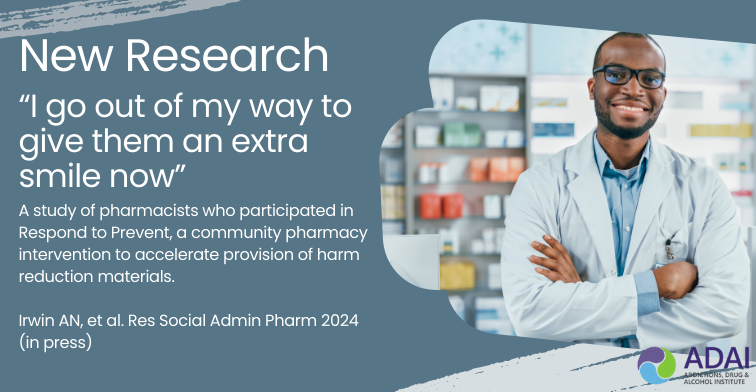New Research: Pharmacists Who Participated in the Respond to Prevent Intervention to Accelerate Provision of Harm Reduction Materials
02/29/2024Citation: Irwin AN, et al. “I go out of my way to give them an extra smile now:” A study of pharmacists who participated in Respond to Prevent, a community pharmacy intervention to accelerate provision of harm reduction materials. Research in Social and Administrative Pharmacy 2024 (in press).

Community pharmacies are well-positioned to improve the health of people with opioid use disorder (OUD) and who use drugs by providing naloxone and other essential public health supplies.
Respond to Prevent (R2P) is an intervention that provides training, resources, and tools to improve the quality and success rate of naloxone offers by community pharmacies using pharmacist- and patient-facing printed materials, a 90-minute online training, and “academic detailing” (in-person peer-to-peer education).
This new paper in Research in Social and Administrative Pharmacy, co-authored by ADAI’s Anthony Floyd, PhD, explored pharmacists’ attitudes, knowledge, and experiences in providing naloxone, dispensing buprenorphine, and selling nonprescription syringes after participation in the R2P program.
Thirty-two pharmacists participated in focus groups, and 4 major themes related to their experiences were identified:
- addressing bias and stigma toward people with OUD and who use drugs (example: “This course helped me to look at each of my patients in a more human aspect, rather than generalizing them as opioid users…”)
- familiarity and comfort with naloxone provision (example: “I use the verbiage in the binder but also just kind of let the conversation flow…”)
- perspective and practice shifts in nonprescription syringe sales (example: “I think patients are becoming more comfortable asking for syringes knowing that we won’t question them and we will even offer a sharps container.”)
- structural challenges to harm reduction in the pharmacy (example: “Price is a major factor why most patients refuse it [naloxone] even [after] explaining the importance of having it on-hand.”)
Participating pharmacists identified attitudes, knowledge, and experiences that create barriers to providing care to people with OUD and who use drugs. The R2P intervention and tools were effective at reducing stigma and changing attitudes, but were less effective at addressing structural challenges from the pharmacists’ perspective.
Need help getting a copy? Email ADAI librarian Meg Brunner, MLIS (meganw@uw.edu)!





